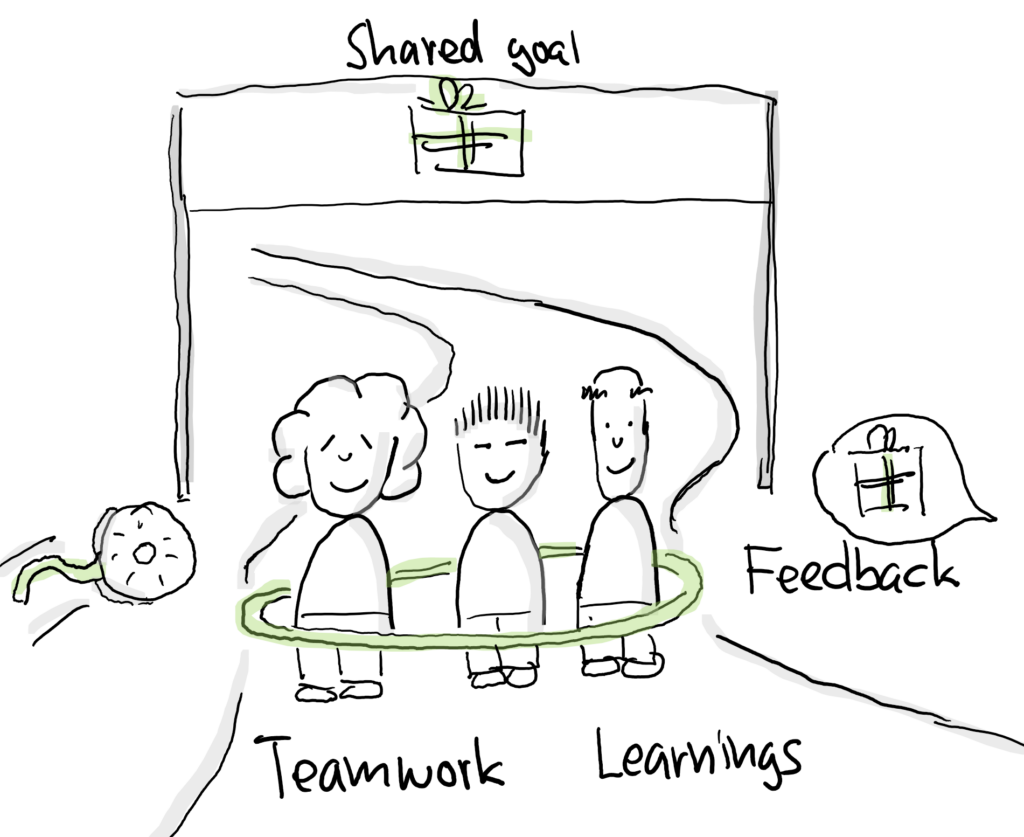Installment sales are great. Instead of spending the whole amount of money up-front – and save for it – you simply pay your monthly deposit. Still, someone will have to pay the interest and cover the risk involved, i.e. you, the buyer. Thus you trade the profit of having something right now with the higher costs. Did you realize, that this is an analogy to how we collaborate?
Today, James is frantically chasing meetings. First, half an hour with the process improvement board, then a meeting in the project team, later a discussion with a colleague about the ever increasing time spent in meetings and so on.
Halfway through the process board meeting, the door opens: “I’ve just found 15 minutes of free time in my schedule today and needed a meeting to fill it up”, says James’ boss and enters the meeting he was invited just out of courtesy. The boss installs himself in a corner, reads emails on his iPad, grunting from time to time. Suddendly, triggered by a hasty keyword, he starts a monologue about his vision of the future visioning process and the meeting is ten minutes over.
James is lucky. Nobody keeps public minutes, and only some take notes. James knows from experience, that the guy who organized the meeting will run around next week: “Can I have you’re notes I’ll have to write the minutes from last weeks meeting!” So whatever James doesn’t like he can simply ignore. And when his colleagues ask hims about the outcomes James grins: “I don’t know yet, I have to wait for the minutes.”
Working collaboratively has challenges:
- Getting into the topic takes time.
- Having a common language takes more time.
- Reaching consensus and a common solution takes even more time.
- Resolving conflicts takes still more time.
- Getting commitment to collaboratively build the best possible solution takes much more time.
It simply takes time for people to form a team. A common language, common goals, shared values, aggreed procedures, team spirit and the motivation to really pull this thing on the road only emerge in intensive interaction.
James however is in a company, where people lease collaboration instead of buying it up-front. That is, instead of taking for example two days in a row in a workshop people meet for an hour once a week, for the next three month.
Leasing collaboration in such a way has costs:
- the bi-weekly one hour meetings are just long enough to get into the topic, but not more,
- the gap between meetings is just long enough so that the little progress made has been drowned in the flood of meetings,
- and participating is optional to some degree anyways, so only half of the invited show up.
However, when we look at the benefit side, surprisingly, there is none: leasing a TV set, we can immediately start using it. The benefit of collaborative work however is the result at the end! There is nothing we can profit from immediately! There is no benefit in return for the additional costs and prolonged payment period!
And then, leasing seems so cheap. Just 50 bucks for this fantastic TV! 80 for the new e-bike! And before you realize it, the monthly pay check is consumed by installment payments for all those products you weren’t able to afford in the first place. And as all responsible persons do in such situations, we now finance whatever comes next with our credit cards.
In order to protect the more easily seduced members of our society, some countries created laws. E.g. in Switzerland, to the best of my knowledge, a payment of a least on third of the price is due up-front. Failing to adhere to this rule will result in a unintentional rebate of 33%.
A team where members work together productively has to evolve. It does not exist by itself. Tuckman’s stages of group development is a model that explains in more detail, that teams build themselves while the team members actually do the work. In this collaboration the members form a common understanding of problem and solution, optimize their processes of working together, create a team spirit, common values and more.
As we know from our own experience, teams do not always build to the best. From all those many reasons three stand out. First, teams need a common task or goal. It is usually a good idea that this goal makes sense to the members and is adequate for the team. Second, teams need a lot of feedback. Teams will optimize their way of working to achieve some goal. But mostly through feedback do teams learn if they are on the right track. Third, teams have to learn and improve themselves. Establishing this team process is crucial for successful teams.

A company like James’ lacks some important structure to form productive teams. Staff have individual goals, collaboration is between individuals, learning does not occur, feedback is on the individual level at best. No wonder, James does not commit to any tasks. As much James enjoys that he can show a lot of involvement without doing the stuff he doesn’t like, there are some projects James is really responsible for. And there the same behaviors prevents his projects to be successful.
A very pragmatic approach in this situation is to run focused workshops with those who really should commit, e.g. a speed creation workshop at the beginning of the project. Such a workshop should achieve the following things:
- Give the future team members a common task and goal.
- Make the team members make a common first step to the project goal, so that team properties begin to evolve.
- Introduce feedback rounds with others, so the team can adapt.
- Make the team reflect their achievements and take measures to improve their work.
Instead of running from meeting to meeting, use focused workshops. Make a common step towards the projects goals with those who really have to commit to do the work and make the decisions.
Don’t lease collaboration without a substantial up-front payment!
For further reading, have a look at the agile innovation process from stars to road. It outlines a collaboration structure for agile innovation.

This thread IS THE STORY OF THIS WEEK.. trying find time between the meetings in order to do some work (and the work I need to do is EXACTLY what will save me from being beaten up in the next meeting).
This thread is almost as good as Dilbert – or it would be if it wasn’t for the bruises !!!
A few observations:
Firstly, “meeting hoppers” will probably never fully engage in the topic, often they want to know what is going on (to take things from the meetings), rarely to they add contribution to final deliverables. I feel that using techniques like Kanban WIP limits can significantly reduce this problem.
Secondly, the teams certainly do need a common goal. It is often taken as read that this means “a common understanding of the goal”, however, the common understanding bit is not always so easy to achieve. To validate this understanding the team certainly need face time, ideally in early stage workshops.
Finally, feedback can be a good thing but not always. How many times have we all heard feedback like “no no no no no no, thats not what we want”. To me, this is the most frustrating and useless feedback that can be given. This “Black Hat” thinking doesn’t add any real value and simply demotivates the team. In order to make progress we really need constructive feedback.
http://en.wikipedia.org/wiki/Six_Thinking_Hats